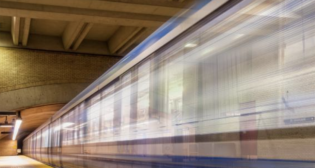
Amtrak at 40: Here to stay — and grow
Written by Douglas John BowenSuppliers have played a key role in helping Amtrak survive, and even prosper, despite repeated attempts to kill the intercity passenger railroad. Their role remains key, and the industry remains optimistic.
It’s still the runt of the U.S. transportation litter, the puny kid at the end of the federal table still deemed by many as too unlikely to grow up, not worthy of even table scraps, even as highway and airport siblings grow sclerotic. For four decades, Amtrak has been told to do more with less, and simultaneously criticized for failing to be a “real” transport option.
And yet Amtrak lives, averaging an operations-to-cost ratio that over the years has been roughly equivalent with vaunted rail mainstay Swiss Federal Railways—a rail network treated with far more respect by its own federal parent and by the world.
Rail industry supplier support may be one little-noticed reason for Amtrak’s success. That support obviously is based on business opportunity, but it’s been anything but fickle; the industry as a whole has stuck with Amtrak through some very tough times.
“Supplier boardroom members may be fiscal conservatives, but they see Amtrak’s value, and they see that federal investment makes economic development possible,” says one railway supply insider. “That’s made a difference over the years, though it remains remarkable that Amtrak has done as well as it has. Its support is bipartisan, and so are its adversaries; both (President Jimmy) Carter and (President Ronald) Reagan despised Amtrak.”
Questions over Amtrak’s mission, and its identity, began even before Amtrak’s birth, including those from Railway Age Editor Luther Miller. Days before Amtrak’s May 1, 1971 launch, Miller noted the odd drive by many to avoid identifying Amtrak as a railroad. “One gets the impression, sometimes, that the incorporators and their consultants would be a lot happier with their new corporation except for one thing. One day soon they are going to have to come down to earth and start running trains. On rails.”
Customers are on board
But Amtrak has slowly clawed its way into railroad respectability, despite numerous failed routes, equipment debacles, and political feuding between a (usually hostile) federal executive and a (usually sympathetic) Congress. Ridership in 2010 was a record 28.7 million, rebounding from 2009 when the Great Recession lingered. Ridership for Fiscal Year 2011, which ends Sept. 30, is on track to break 2010’s mark.
More customers may help translate to voter support as Amtrak yet again encounters its own Perils of Pauline. Of the roughly $39 billion in cuts to the Fiscal Year 2011 budget passed by Congress this spring, $128 million comes from Amtrak’s budget for capital improvements and debt service, according to the National Association of Railroad Passengers.
More cuts are possible for Amtrak in FY12, but unlike previous years Amtrak foes won’t be able to rely on the “no riders” argument; the carrier has notched 17 straight months of ridership growth, and is on target to surpass its record ridership recorded in 2008. “Don’t be surprised if Amtrak bashers take a wholly different tact—that it doesn’t need the money because it’s successful,” one retired Amtrak employee says, adding, “Of course, they don’t make that case for highways.”
Needs backlog, job opportunities
Amtrak in 1971 was a mishmash of differing (and often incompatible) passenger equipment from numerous railroads offering service on only the skeletal remains of a national system.
Tales abound of Pennsylvania Railroad GG1s running on ex-New Haven Line trackage in Connecticut and tearing down overhead wires due to brief gaps over bridges—and pantographs rising way too high seeking them, only to ensnare wires ahead. Beyond such spectacular pitfalls, however, more mundane shortcomings plagued the system. Amtrak’s inherited fleet was mostly steam-heated, with head-end power still to come. In 1976, Amtrak assumed ownership of the Northeast Corridor, with infrastructure components in some cases dating back to 1912.
“I’m old enough to remember what the trains were like in the 60s and 70s when I rode them,” says Railway Supply Institute President Tom Simpson. “People forget, or just don’t know of, the transition from steam heat to HEP, and how hard it was for Amtrak to keep equipment built in the 1940s and 1950s running in the 1970s or 1980s.”
Amtrak itself recently has noted some of that equipment still is in service today. “We’ve underinvested since the 1960s, and the dribs and drabs of investment, combined with Buy America regulations, as a whole has not been fair to Amtrak, its passengers, or the supply industry, who can supply modern, fuel-efficient, passenger-friendly equipment,” Simpson says.
Stable funding source sought
The Obama Administration has proven more friendly to Amtrak than its predecessors have, in part due to the influence of Vice President Joe Biden, an ardent Amtrak supporter and defender for many years in the U.S. Senate. Congress, while containing anti-Amtrak elements, seems reluctant to terminate Amtrak outright, but funding support once again has become a critical issue, prompting industry players, including the RSI, to seek a different approach.
“We can’t support Amtrak solely through the appropriations process,” Simpson says. “We need some kind of funding proposal,” possibly modeled after the approach used to establish the Interstate highway system, he says. “We have to figure out some dedicated funding source so Amtrak, or any other carrier, or the passenger, and especially the supplier, can plan.”
As part of any solution, RSI supports H.R. 825, the Surface Transportation Safety Act of 2011; among other safety initiatives, the act would help preserve the Section 130 program, funding grade-crossing safety improvements, in the next surface transportation bill at $220 million per fiscal year. “With rail freight traffic beginning to rebound, the promise of more and faster passenger trains in the next few years, and increased highway traffic, now is not the time to turn our back on this program,” Simpson says.
Promoting the innovative Amtrak
Amtrak, as well as its suppliers, needs to get the word out that the railroad is anything but stuck in the past, says Guilliame Mehlman, managing director-North America for Alstom Transport. Right now, even Amtrak supporters often deride the National Passenger Railroad Corporation as a hidebound, stuck-in-the-past business model—an image Mehlman believes lingers unfairly.
“Amtrak as a customer actually is one of the more innovative, open customers,” asserts Mehlman. “Amtrak is taking a lead in products, it’s active in standards committees, it’s among the leaders in material management, and a leader in operating our Acela equipment,” itself a joint effort between Alstom and Bombardier Transportation.
Even if one grades on a curve for the North American passenger rail market compared with sleeker European or Asian counterparts, Mehlman says, “Wi-Fi at 150 mph—if that’s not innovative, I don’t know what is.”
Moreover, Mehlman says, “Amtrak has allowed us to be innovative, and it’s taken an innovative position in letting us do that.” Mehlman cites Amtrak’s move 10 years ago to develop a variant of Positive Train Control, ACSES, on the NEC as one example; Alstom continues to assist regional and commuter railroads on the NEC with their PTC requirements.
The trick may be to get the message out. “It’s key that Amtrak gets more visibility than it has had; it has a great need of fleet replacement and infrastructure needs,” says Mehlman. If Amtrak and its supporters can do that, “We’re confident that we’ll get through the current [congressional] debate.”



